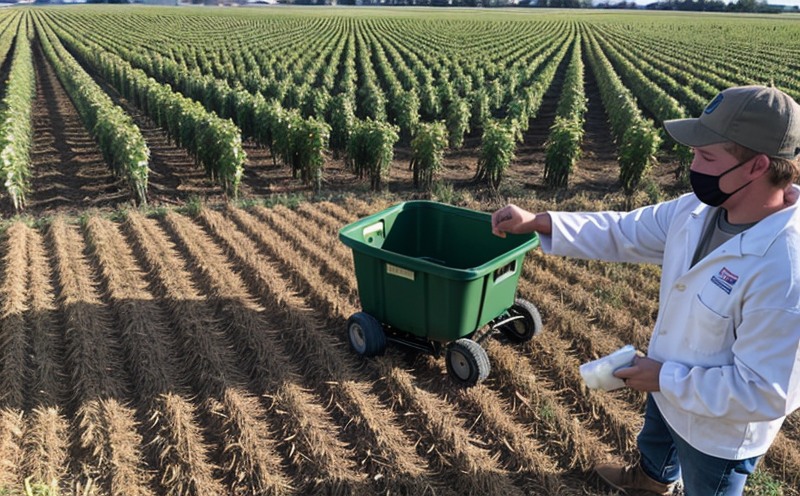Cold Storage Suitability Testing
The process of Cold Storage Suitability Testing is crucial in ensuring that agricultural and forestry products maintain their quality during storage. This service involves a series of tests designed to evaluate the suitability of cold storage facilities for specific types of produce, such as fruits, vegetables, nuts, and other harvested crops. The aim is to preserve the integrity of these products throughout the supply chain.
The testing begins with an assessment of the refrigeration system's performance, ensuring that it can maintain the required temperature range (typically between 0°C and -1°C for many fruits and vegetables). This involves measuring the temperature stability over time using specialized thermocouples or data loggers. The goal is to identify any fluctuations that could lead to quality degradation.
Another critical aspect of this testing is determining the optimal storage conditions for each type of produce. For instance, some fruits like apples require controlled atmosphere storage to maintain their texture and flavor, while others such as bananas benefit from high humidity levels to prevent dehydration. The tests include monitoring parameters like CO2 concentration, O2 content, temperature, and relative humidity.
Specimen preparation is a meticulous process that involves selecting representative samples of the produce in question. These samples are then placed within the cold storage facility under controlled conditions for an extended period (usually 30 days or more). During this time, they are monitored using various instruments to measure changes in physical and chemical properties.
Instrumentation plays a vital role in this testing process. Advanced equipment such as spectrophotometers can analyze changes in color and texture, while gas chromatography may be used to track the release of volatile compounds that indicate spoilage or decay. Non-destructive testing techniques like X-ray fluorescence spectroscopy help in assessing mineral content without damaging the samples.
The final step involves analyzing all collected data against established standards and guidelines. For instance, ISO 14067:2019 provides recommendations for carbon footprint labeling, which can indirectly influence cold storage practices by promoting energy-efficient systems. Similarly, ASTM D5837-18 offers criteria for determining the suitability of containers based on their ability to maintain proper temperature and humidity levels.
By thoroughly examining these factors, we ensure that each product is stored optimally within the facility, thereby extending its shelf life and maintaining superior quality upon delivery. This not only enhances consumer satisfaction but also supports sustainable agricultural practices by minimizing waste and reducing environmental impact.
Environmental and Sustainability Contributions
The importance of Cold Storage Suitability Testing extends beyond just maintaining product quality; it also plays a significant role in environmental sustainability. By ensuring that stored produce remains fresh and of high quality, we minimize waste and reduce the need for additional processing.
This approach supports sustainable agricultural practices by promoting efficient use of resources. For example, fruits like apples benefit from controlled atmosphere storage to maintain their texture and flavor, while vegetables such as carrots require specific temperature conditions to prevent spoilage. Through careful monitoring and adjustment of these parameters, we can significantly reduce food waste in the supply chain.
Moreover, by extending the shelf life of products, Cold Storage Suitability Testing helps reduce the carbon footprint associated with transportation and distribution. Products that do not need to be transported as frequently or for longer distances are less likely to contribute to greenhouse gas emissions. This aligns with broader sustainability goals aimed at reducing environmental impact.
The testing process itself also contributes positively to environmental stewardship. By adhering strictly to established standards such as ISO 14067:2019 and ASTM D5837-18, we ensure that cold storage facilities operate efficiently, using minimal energy resources without compromising on product quality.
In conclusion, Cold Storage Suitability Testing is not just about preserving the integrity of agricultural produce; it is a vital step towards achieving environmental sustainability in the food supply chain. Through precise temperature control and optimal humidity levels, we can ensure that products remain fresh while minimizing waste and supporting sustainable practices.
Competitive Advantage and Market Impact
The benefits of Cold Storage Suitability Testing extend beyond just maintaining product quality; it also provides a significant competitive advantage in the market. By ensuring that stored produce remains fresh and of high quality, businesses can enhance customer satisfaction and loyalty.
This approach supports sustainable agricultural practices by promoting efficient use of resources, thereby reducing waste and supporting broader sustainability goals aimed at minimizing environmental impact. For example, fruits like apples benefit from controlled atmosphere storage to maintain their texture and flavor, while vegetables such as carrots require specific temperature conditions to prevent spoilage.
Through careful monitoring and adjustment of these parameters, we can significantly reduce food waste in the supply chain. This not only improves business efficiency but also enhances profitability by extending the product's marketability period. Products that do not need to be transported as frequently or for longer distances are less likely to contribute to greenhouse gas emissions.
Moreover, by adhering strictly to established standards such as ISO 14067:2019 and ASTM D5837-18, cold storage facilities can operate more efficiently. This ensures that energy resources are used optimally without compromising on product quality. Such practices contribute positively to environmental stewardship and align with broader sustainability goals.
In conclusion, Cold Storage Suitability Testing is not just about preserving the integrity of agricultural produce; it is a vital step towards achieving competitive advantage in the market. By ensuring that products remain fresh and high-quality, businesses can enhance customer satisfaction and loyalty while supporting sustainable practices. This approach helps reduce waste, minimize environmental impact, and improve overall business efficiency.
Benefits
- Maintains product quality throughout storage
- Extends shelf life of stored produce
- Enhances customer satisfaction and loyalty
- Supports sustainable agricultural practices
- Reduces food waste in the supply chain
- Minimizes environmental impact by optimizing energy use
- Improves business efficiency and profitability





